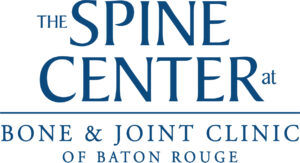
Do you have a herniated disc in the lower back? Here’s what it is, common causes & treatment options
Sponsored by the Spine Center of Baton Rouge
A herniated disc – sometimes called a slipped, ruptured or bulging disc – is one of the most common causes of lower back pain. The condition affects between 60 and 80 percent of people at some point in their lives.
Although a herniated disc can be painful, most people feel better within a few weeks or months of nonsurgical treatment. A small percentage require surgery. Read more from spine surgeon Dr. Kevin McCarthy, who has been in practice since 2005 treating patients with neck pain, back pain and nerve pain, at the Spine Center of Baton Rouge.
What causes a herniated disc?
A herniated disc can be caused by sudden injury, but it is often the result of natural, age-related wear and tear on the spine. When we are younger, these spongy tissues in between our spine’s vertebrae keep our spine comfortable and flexible as we twist and bend. But as we age, the discs get drier and become less flexible, increasing the risk for a ruptured disc.
When the disc’s soft center pushes against its outer ring, this pressure can cause lower back pain. If the pressure continues, it may push all the way through the disc’s outer ring or cause the ring to bulge, putting pressure on the spinal cord and nearby nerve roots.
What are the risk factors?
Poor posture: If you slump and slouch, you put extra pressure on your vertebral discs. One of the greatest sources of poor posture is looking down at your phone or tablet throughout the day.
Heavy lifting: If you need to lift heavy weights for your job, you’re more at risk for a slipped disc. Always center the weight of the object in your thigh muscles, which takes the stress off your spine.
Weight: Excess pounds put added stress on the discs in your lower back, making you more likely to have a slipped disc than someone who’s lighter.
Lack of exercise: When you move your joints, they release synovial fluid that lubricates and protects them. Back-friendly exercises such as walking, cycling or swimming can help prevent many medical conditions, including herniated discs.
Smoking: Smoking dehydrates your tissues, including the rubbery cushion of the vertebral discs. Your vertebral discs need healthy, oxygen-rich blood that’s full of nutrients so they can repair and replace dead or dying cells.
What are my treatment options?
Nonsurgical treatment options provide relief for most patients. These include rest, taking anti-inflammatory drugs such as ibuprofen or naproxen, physical therapy, and epidural steroid injections.
For patients who do not experience relief, spine surgery may be recommended. The most common procedure is called a microdiscectomy, where the surgeon removes the herniated part of the disc and any additional fragments that are putting pressure on the spinal nerve.
If you are experiencing lower back pain or radiating leg pain, call the Spine Center of Baton Rouge to discuss it with a physician. More information is also available at spinecenterbr.com.

